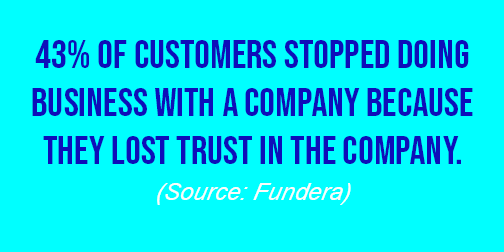Last week, I had an overcharge issue with my phone provider.
A tweet mentioning the service provider got me a prompt response from the official Twitter account. I was advised to call the service center.
From there, things rapidly went south.
After wading through a frustrating automated system, I was stuck in a queue for 30 minutes. Then, finally, I was able to talk to a human being.
For all I know, the conversation was carried out in the middle of a fire alarm. I was rushed and barely got to tell my side of the story.
Here is how it went:
Me: You guys are over charging me this month. I haven’t…
Operator: I am sorry, Sir, but you will have to pay. We can look into the matter if you submit a ticket.
Me: Can’t you submit a ticket for me? How much time …..
Operator: I can’t do that. That’s done by customers online. It can take up to 6 weeks. Anything else?
Me: So, will I have to pay for these charges in my next monthly bill too? And will they go away?
Operator: I can’t promise anything. You have to pay the charges on your bill. Thank you for calling us.Click.
See the disconnect here?
Compare the initial Twitter response to a relaxed conversation between friends at a corner cafe. In contrast, my phone conversation was like having a lonely burger at a fast food chain.
This is what an inconsistent customer experience looks like. And, it can kill any business, big or small.
How can you keep this from happening to your customers? Pay close attention to the following 5 tips for consistent customer experience.

What is consistent customer experience?
Consistent customer experience means providing high-quality service across all channels. It ensures seamless, reliable interactions every time customers engage with a business. Whether through chat, email, phone, or in-person, consistency builds trust, boosts loyalty, and reduces frustration. It requires uniform messaging, tone, and support standards, no matter the channel or agent. A consistent approach fosters familiarity and dependability, improving customer satisfaction and retention.
1. Work on your branding
A brand is more than a pretty logo or a slick website. It’s also a set of mental associations, shaped by brand architecture, that customers make when they think about you.
This highlights how brand architecture plays a role in organizing and influencing the perceptions people have of the brand.
Big businesses aren’t the only ones that need to focus on this strategy. Branding is important for small business, too.
Here are some examples of successful branding:
- McDonald’s brand image is that they sell cheap food that tastes the same everywhere.
- Amazon’s brand image is that you can find anything you want to buy…and get it shipped to you directly.
- Apple’s brand image is that they make cutting-edge computers and phones that connect consumers to the world.
What do customers associate with your brand? Is it a positive feeling that helps them move forward on their buying journey?
Here’s a tweet from Growth Hackers’ CEO, Jonathan Aufray, that breaks down the elements of successful branding:
The 4 things your #brand needs:
– Trust
– Value
– Dialogue
– Meaning#Branding #DigitalMarketing #MarketingAgency #MarketingStrategyVia @ninestudiosuk pic.twitter.com/j4CprmYo3l
— Jonathan Aufray ☕ (@JonathanAufray) May 23, 2019
2. Develop a healthy work culture
Even in today’s highly automated environment, there will still be times when customers will have to interact with your employees.
Whether you run a restaurant or an online retail store, never forget that your staff is the face of your company.
According to the Gallup report “The State of the American Workplace” employees who are engaged are more likely to improve customer relationships, with a resulting 20% increase in sales.
One way to ensure consistency and that they are engaged is to improve their job satisfaction by fostering a healthy work environment.
How your employees conduct themselves goes a long way towards determining whether customers receive a consistent experience. One disengaged employee can give the entire company a bad name.
If one of your employees behaves negatively with a customer, it takes 12 positive interactions to undo that bad impression. Don’t let that happen to your brand.
Related Post: Five Ways to Make Employees Happy
3. Focus on training
When finances are tight, training budgets are usually the first to get cut. However, this is counterproductive.
Consumers are always there, even during recessions. And, customers won’t be very happy if your employees don’t know what customer service pitfalls to avoid.
It’s impossible for your employees to be magically customer-oriented. That’s why it is imperative to invest in proper training.
“Investing in quality talent, and ensuring they have the skills, training and tools that enable them to empathize and actively listen to customers are central to providing consistently excellent service experiences,” points out American Express Executive VP, Jim Bush.
A well-planned employee training program will get you headed in the right direction.
4. Achieve unified customer communications
What makes a coffee shop or bar your favorite? Most likely, your first answer is good food and/or drinks.
However, I am willing to bet that you also like going there because of the service you receive. The staff may even know you well enough to make suggestions based on your tastes.
Every company should strive to achieve this level of intimacy with its customers. For this to happen, the entire staff must have access to information like previous complaints and former purchases.
Related Post: Using E-Mail profiles to personalize outgoing email
According to Accenture, 81% of consumers want brands to get to know them and understand when to approach them and when not to. To achieve this, all employees will have to know the details of customers’ past transactions.
The technology for this level of customer orientation is available, in the form of CRM software, data mining tools, and integrated live chat and ticket support systems.
Here’s a tweet from Commercient with a link to some tips on how to choose the right CRM.
Today’s business landscape has become data-driven and more competitive than ever before. That’s why CRM is a must. Here are tips to choose the right #CRM software for our business: https://t.co/Ut5BqLFoxu pic.twitter.com/jVdrsRwKcb
— Commercient (@Commercient) May 23, 2019
5. Keep your promises
Don’t claim your company provides superior service and not follow through. According to Fundera, 57% of customers would stop using a brand if they had a negative review go unaddressed.
Never leave a customer behind. Be vigilant on any communication channel where your company has a presence — across the board.
These all count:
- snail mail
- voicemail
- Google Reviews
- blog comments
- social media (every single one)
- suggestion boxes
- messenger pigeon (see where I’m going with this?)
If you can’t keep your promises, you’ll lose their loyalty. And, if you don’t have their loyalty, you have nothing.
Don’t believe it? 43% of customers stopped doing business with a company because they lost trust in the company.

Have you found these tips helpful?
What suggestions would you add towards delivering a consistent customer experience?




